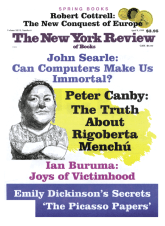In response to:
A la Recherche du Temps Perdu from the December 3, 1998 issue
To the Editors:
Tony Judt’s review of Realms of Memory [NYR, December 3, 1998] is somewhat unfair in its “false past” accusation against the Nice city authorities. Their bilingualization of l’avenue Jean Médecin follows practice now rife throughout the South of France—although more typically Provençal or Occitan proper is used. Nice’s use of the local dialect, Nissart, has some justification, however.
Jean Médecin, whose son Jacques died very recently, belonged to a generation which still preserved Nissart, in the back streets and the arrière-pays, against the uniformity required by the French education system. It was only sixty-eight years before his first election, and his son’s birth, that the ancien comté de Nice became finally part of France.
Before that Ubraye, where this letter was conceived, thirty-two miles west by northwest of Nice, was frontier territory—between France and Piedmont—and subject to three-way cultural tension.
The man who built our house with his own hands bridged those Médecin generations. When he wanted to express how he felt about the house, he chose Nissart as the medium for calling it “the house [which] made us sweat”—maioun nas fas suda. In its own way this, certainly, falls within a “realm of memory.”
Michael Laschinger
Ubraye, France
Tony Judt: replies:
Mr. Laschinger has a point. Nice and its hinterland have had a checkered relationship to the French state—in early medieval times the city was sometimes independent, sometimes a fiefdom of the counts of Provence, before becoming the property of the rulers of Piedmont and Savoy in the fourteenth century. Despite the efforts of Louis XIV and Napoleon Bonaparte, the area remained part of the Kingdom of Piedmont until it was definitively transferred by treaty to France in 1860. In the back country various mixes of Provençal and Italian long remained in active use—as recently as the early 1970s I recall listening to conversations among elderly villagers there conducted in the “old” tongue.
But the ruling elite of Nice itself, like that of Italian Piedmont more generally, always spoke French and for many decades following the French takeover would have been quite offended to be associated with a “backward” dialect. The impact of linguistic centralization in France’s far-flung provinces was always felt (and frequently resented) above all by the lower classes. And by the time Jean Médecin became mayor, nearly seventy years after the establishment of French rule, it was quite normal for all public business and most private communications to be conducted in the national language. The politically sensitive search for local linguistic roots in southern France is thus a recent concern; and it is always in danger of identifying and claiming continuities and practices whose anachronistic invocation constitutes a sort of invented memory. I readily concede, however, that the story looks a little different in the hill villages of the Provençal Alps, and it is good to learn that the unbroken memory of another time and tongue is still with us in Ubraye.
This Issue
April 8, 1999



